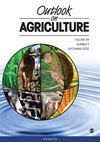Shaping India's climate future: A perspective on harnessing carbon credits from agriculture
IF 2.6
3区 经济学
Q1 AGRICULTURE, MULTIDISCIPLINARY
引用次数: 0
Abstract
Human activities are responsible for emitting greenhouse gases (GHGs) that contribute to global warming and climate change. As the world's second-largest producer of staple food and the third-largest emitter of GHGs, India has been witnessing an increase in demand for food and energy, resulting in increased emissions. Thus, to achieve net carbon neutrality by 2070, India must focus urgently on climate change mitigation. Its agriculture sector has the potential to transition from being a net emitter to a net absorber of GHGs by adopting sustainable farming practices such as zero tillage, laser-assisted precision land leveling, direct seeding of rice, intercropping, biochar application, use of solar energy, and more efficient management of irrigation water, soil nutrients, livestock feed, and manure. To incentivize climate consciousness, a voluntary carbon credit trading system could be utilized in agriculture, supported by a measurement, monitoring, reporting, and verification platform. This system would also bring about social, environmental, and financial co-benefits for its stakeholders. Specifically, the agriculture sector could substantially reduce the country's annual emissions by 84% from 2019 to 2070. But to realize their potential, the carbon markets must overcome the limitations currently set by policy, economic, cultural, and biophysical factors.塑造印度的气候未来:利用农业碳信用额的视角
人类活动排放的温室气体(GHGs)导致全球变暖和气候变化。作为世界第二大主食生产国和第三大温室气体排放国,印度对粮食和能源的需求不断增加,导致排放量增加。因此,要在 2070 年之前实现净碳中和,印度必须紧急关注减缓气候变化问题。通过采用零耕作、激光辅助精确土地平整、水稻直播、间作、生物炭应用、太阳能利用以及更有效地管理灌溉水、土壤养分、牲畜饲料和粪便等可持续耕作方法,印度的农业部门有可能从温室气体净排放国转变为温室气体净吸收国。为激励气候意识,可在农业中采用自愿碳信用交易系统,并辅以测量、监测、报告和验证平台。该系统还将为利益相关者带来社会、环境和财务方面的共同利益。具体而言,从 2019 年到 2070 年,农业部门可将该国的年排放量大幅减少 84%。但是,要实现其潜力,碳市场必须克服目前由政策、经济、文化和生物物理因素造成的限制。
本文章由计算机程序翻译,如有差异,请以英文原文为准。
求助全文
约1分钟内获得全文
求助全文
来源期刊

Outlook on Agriculture
农林科学-农业综合
CiteScore
5.60
自引率
13.30%
发文量
38
审稿时长
>36 weeks
期刊介绍:
Outlook on Agriculture is a peer reviewed journal, published quarterly, which welcomes original research papers, research notes, invited reviews and commentary for an international and interdisciplinary readership. Special attention is paid to agricultural policy, international trade in the agricultural sector, strategic developments in food production, the links between agricultural systems and food security, the role of agriculture in social and economic development, agriculture in developing countries and environmental issues, including natural resources for agriculture and climate impacts.
 求助内容:
求助内容: 应助结果提醒方式:
应助结果提醒方式:


